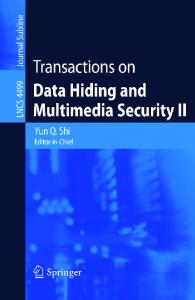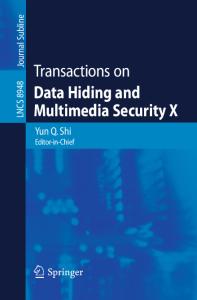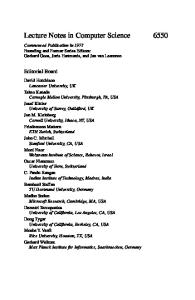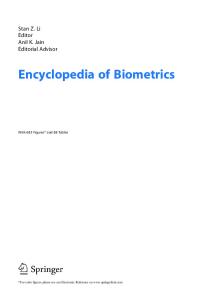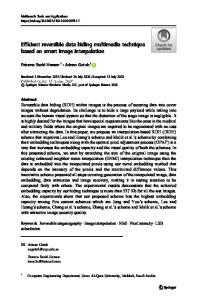Transactions on Data Hiding and Multimedia Security IV
Since the mid 1990s, data hiding has been proposed as an enabling technology for securing multimedia communication, and is now used in various applications including broadcast monitoring, movie fingerprinting, steganography, video indexing and retrieval,
- PDF / 3,777,906 Bytes
- 111 Pages / 430 x 660 pts Page_size
- 17 Downloads / 279 Views
Editorial Board David Hutchison Lancaster University, UK Takeo Kanade Carnegie Mellon University, Pittsburgh, PA, USA Josef Kittler University of Surrey, Guildford, UK Jon M. Kleinberg Cornell University, Ithaca, NY, USA Alfred Kobsa University of California, Irvine, CA, USA Friedemann Mattern ETH Zurich, Switzerland John C. Mitchell Stanford University, CA, USA Moni Naor Weizmann Institute of Science, Rehovot, Israel Oscar Nierstrasz University of Bern, Switzerland C. Pandu Rangan Indian Institute of Technology, Madras, India Bernhard Steffen University of Dortmund, Germany Madhu Sudan Massachusetts Institute of Technology, MA, USA Demetri Terzopoulos University of California, Los Angeles, CA, USA Doug Tygar University of California, Berkeley, CA, USA Gerhard Weikum Max-Planck Institute of Computer Science, Saarbruecken, Germany
5510
Yun Q. Shi (Ed.)
Transactions on Data Hiding and Multimedia Security IV
13
Volume Editor Yun Q. Shi New Jersey Institute of Technology University Heights, Newark, NJ 07102-1982, USA E-mail: [email protected]
Library of Congress Control Number: Applied for CR Subject Classification (1998): K.4.1, K.6.5, H.5.1, D.4.6, E.3, E.4, F.2.2, H.3, I.4
ISSN ISSN ISBN-10 ISBN-13
0302-9743 (Lecture Notes in Computer Science) 1864-3043 (Transactions on Data Hiding and Multimedia Security) 3-642-01756-8 Springer Berlin Heidelberg New York 978-3-642-01756-8 Springer Berlin Heidelberg New York
This work is subject to copyright. All rights are reserved, whether the whole or part of the material is concerned, specifically the rights of translation, reprinting, re-use of illustrations, recitation, broadcasting, reproduction on microfilms or in any other way, and storage in data banks. Duplication of this publication or parts thereof is permitted only under the provisions of the German Copyright Law of September 9, 1965, in its current version, and permission for use must always be obtained from Springer. Violations are liable to prosecution under the German Copyright Law. springer.com © Springer-Verlag Berlin Heidelberg 2009 Printed in Germany Typesetting: Camera-ready by author, data conversion by Scientific Publishing Services, Chennai, India Printed on acid-free paper SPIN: 12678990 06/3180 543210
Preface
In this volume we present the fourth issue of the LNCS Transactions on Data Hiding and Multimedia Security containing five papers on digital watermarking. The first three papers deal with robust watermarking. In the first paper, Piper and Safavi-Naini address the issue of how many images should be used in experiments to evaluate the robustness of watermarking algorithms in order to have confidence in the experimental results. A statistical approach based on hypothesis testing and power analysis is provided to determine this number. The second paper, by X. Qi and J. Qi, proposes a content-based desynchronization resilient watermarking scheme, which combines the advantages of feature extraction, perceptual analysis, one-way hash functions, and spread-spectrum-based blind watermark embedding an
Data Loading...
